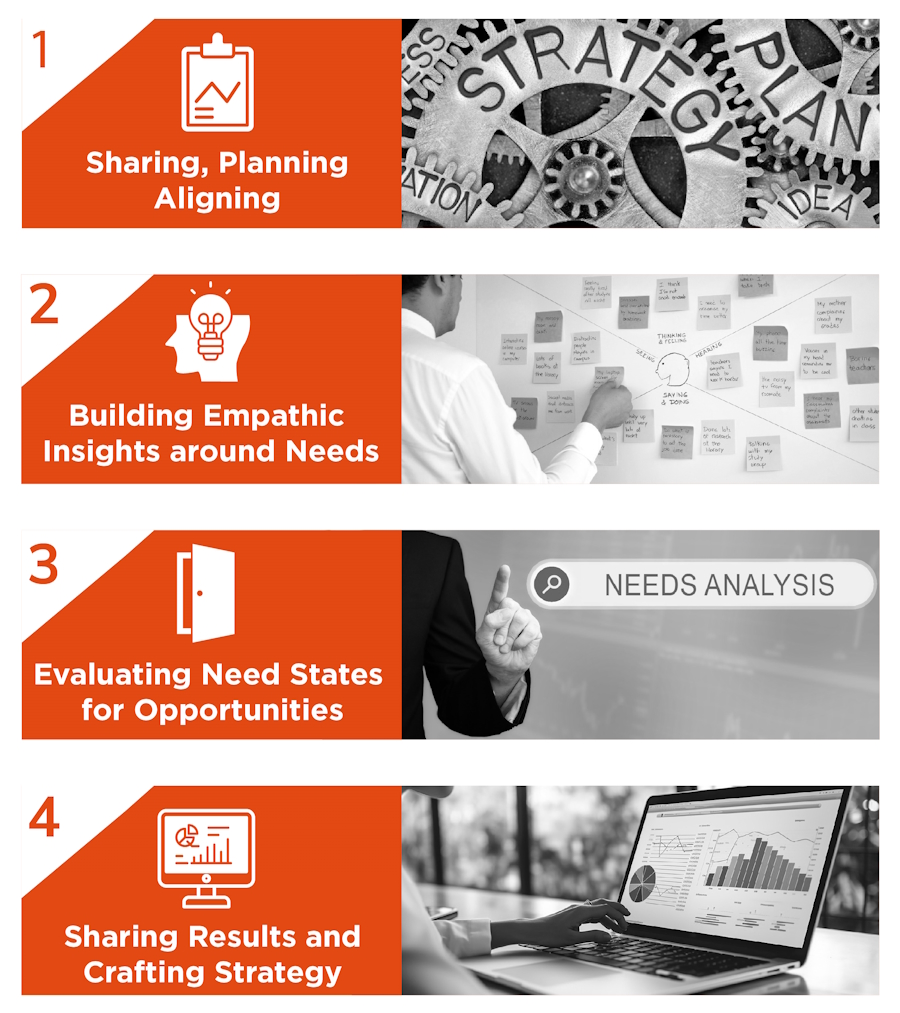
market Segmentation Research:
a comprehensive guide
Kat Figatner
Senior Vice President, In-Person Qualitative Research
Paul Metz
Chief Executive Officer, C+R Team

Robbin Jaklin
Former President, C+R Alum
Overview
Your prospects and customers are not all the same—segmentation research helps guide your targeting and messaging strategies.
Market segmentation in consumer research is essential for effective marketing, as it recognizes that products and services cannot appeal to everyone universally. By identifying specific groups with varying attitudes, needs, and motivations, segmentation research enables companies to develop a targeted portfolio of brands and tailor marketing communications to distinct consumer segments.
Segmentation should be purpose-built and customized for each product category, involving an investigative and often multi-modal phased design and analysis process.
Defining segmentation
Customer segmentation refers to the process of dividing a customer base into groups of individuals that are similar in specific ways relevant to marketing, such as age, gender, interests, spending habits, and so on. It enables businesses to target these groups effectively and allocate marketing resources to the best possible effect.
Segmentations vary in complexity and analytical depth:
- Simple segmentations use straightforward criteria like generation or ethnicity, relying on cross-tabulated data.
- Intermediate segmentations apply basic advanced analytics, such as cluster analysis on Attitude & Usage study data.
- Complex segmentations are in-depth, often the main focus of the study, requiring iterative and/or multi-modal processes with extensive use of advanced analytics.

When do you need a
segmentation study?
Typically segmentations are done to:
- Uncover new growth opportunities through tailored, industry-specific segmentation research.
- Understand the array of consumer experiences and needs.
- Develop engaging personas and creative presentations for segmentation results.
- Help refine and expand a brand’s target market share more effectively.
- Deliver actionable, “living” segmentations for effective organizational implementation.
Exploring types of segmentation
There are an endless number of ways you can segment. These are a few of the common methods C+R employs:
- Shopper Segmentation: Shopper – groups people based on their needs, attitudes, and behaviors when shopping for a product or service. Our proprietary Shopper Segmentation can easily be incorporated into your research initiatives.
- Attitudinal Segmentation: (also known as Psychographic Segmentation) Groups people with similar attitudes, then profiles them using demographics, behaviors, brand perceptions, media habits, etc., for targeted strategies.
- Occasion-Based Segmentation: Focuses on product/service use in different situations, identifying diverse consumer needs and opportunities for growth.
- Behavioral Segmentation: includes key aspects of purchase behavior, usage rates, and benefits sought from a product or service. It is particularly useful in tailoring marketing messages and promotions to fit specific consumer habits, enhancing customer engagement and retention.
- Marrying Behavior with Attitudes: Combines transactional and attitudinal data to form unique segments.
- Geographic Segmentation: This type of segmentation divides the market based on geographic boundaries or characteristics. This can refer to regional or location-based, climate or cultural preferences impacted by geography.
- Needs-based: Categorizes consumers based on their specific needs and desires regarding products or services. It focuses on identifying what drives customer purchases, ranging from functional requirements to emotional or psychological desires.

Read a segmentation case study
Learn how we partnered with an alcoholic beverage client to develop a comprehensive occasion-based segmentation, including how we worked to bring segments to life.
Getting started:
what’s the right segmentation to use?
As with other custom research, one size does not fit all, and the segmentation should be designed based on what you are looking to accomplish. For example, each of our client situations is unique, so our recommended solution is really based on getting to know their business intimately and understanding how they intend to use the segmentation.
This process entails the following four phases, addressed in further detail in our segmentation eBook.

The methodology of segmentation
in marketing
Phase 1: Sharing, Planning and Aligning
Stakeholder Engagement and Kickoff Meeting
This initial phase is critical for the success of segmentation studies, involving considerable client investment and diverse stakeholder input. It starts with in-depth, individual interviews with key internal stakeholders to gather insights about the current market, future directions, and each stakeholder’s vision of success. These insights are crucial for shaping the research and garnering stakeholder buy-in. The findings from these interviews lay the groundwork for the kickoff meeting, a structured group discussion to further share knowledge, align objectives, and address any additional information relevant to the study, such as market trends, specific demographic insights, or the impact of external factors.
Phase 2: Building Empathetic Insights Through
Qualitative Research
Understanding Consumers and Their Point of View on the Category
- Explore target consumers’ values, lifestyles, and how they perceive the category, including the fit of different products/brands.
Identify Motivations, Jobs, and Perceptions
- Analyze needs and behaviors in various contexts.
- Identify roles fulfilled by specific products/brands in the category.
- Investigate the decision-making process and brand perceptions to reveal factors influencing client’s brand and competitors.
Develop Hypotheses and Update Language
- Use qualitative insights to create language reflecting consumer perceptions and motivations.
- Involve Cohort Experts for multicultural consumer insights.
- Form an initial framework for validation in the quantitative phase.
Process and Techniques
- Overview of methodologies utilized in market segmentation.
Phase 3: Evaluating Need States and Survey Execution
This is the most involved stage. It includes everything from designing the sample, developing the questionnaire, and creating segmentation models. After gathering qualitative insights and formulating hypotheses, the questionnaire is developed, typically over 20 minutes, with the sample size adapted to the diversity of the target audience.
Pilot studies are employed to refine the survey, focusing on differentiating attributes through factor analysis. Once the data is collected, the segmentation process involves data preparation, such as removing poor quality responses and doing advanced analytics controlling for scale-use bias, and selecting appropriate segmentation analytics like ensemble clustering, latent class, or K-means based on data types. The final steps include segmentation validation techniques, ensuring stable and accurate segment classification.
Phase 4: Evaluating Need States and Survey Execution
The final stage of the segmentation study is to make the information digestible for your stakeholders.
An iterative approach with work sessions helps integrate the learning into the organization. It’s important to present data in a visually appealing and engaging way to maintain interest. Techniques to bring segments to life are also employed for clearer understanding.
The process culminates in a final presentation involving a cross-functional client team, where strategies and tactics for key segments are developed and activated.

custom segmentation research
case studies and examples
- Applied Case Study: Reference to the Kid Retail Strategy Case Study for practical application.
- Effective Segmentation of Moms Case Study.
- Targeting Donors Case Study
- For a more off the shelf solution, explore C+R’s SmartMarket Segmentation blog.
Tools and analytics for segmentation
Data Preparation involves removing poor quality data: respondents who answer with low-variability or inconsistent answers. We also control for scale-use bias: Because respondents use scales differently, it’s essential to take steps to control for that bias so that data is standardized across cases. Solutions involve either normalizing scale data or using scale measurements that avoid scale bias, such as Max-Diff utilities.
Segmentation analytics are chosen based on the type(s) of data used in the segmentation: categorical, binary, scaled, ranked, choice-based utilities, metric (such as counts or spend), or a mix of measures. Some examples include:
- Ensemble clustering: which uses several different algorithms to run hundreds of solutions, then aggregate the results into the most reproducible segments.
- Latent class: appropriate for clustering with variables of many different data types.
- K-means: a basic clustering method used on variables with equal variance.
- Hierarchical: applied to market structure studies to build taxonomies of products.
- Segmentation Validation is a step to ensure that the analytic solutions provide stable and accurate classification into segments.
- Information criteria: Akaike and Bayesian Information Criterion allows for direct model comparison to maximize likelihood while minimizing the overlapping that might occur with many segments.
- Split-half validation: Predict half of the cases out of sample using solution on the other half.
- Reproducibility: Test the ability of the solution to classify future cases into the existing model.
The segmentation solution is final: time to tell the story and develop personas
Once the segmentation solution is finalized, each segment will be profiled, sized, and prioritized for meeting the brand’s objectives for growth. Personas are created so that segments are presented in a quick and easily
digestible way for the stakeholders to understand everything about the segments. Following are some examples:

Bringing the segments to life
We always encourage our clients to add one of the following methods for bringing the segments to life. Many times, we will involve C+R’s Storyologists to connect our clients to the segments to build understanding and empathy.
Video Clips that represent people from
different segments—can be collected via online
discussions, webcam interviews, or video
platforms such as VoxPopMe.
Video Sizzle Reels — can be created using video
clips to capture key insights in a compelling
way—either more artistically stylized or more
ethnographic documentary style.
Look Books — a tangible “book” to give to your
stakeholders to use as a segment reference
“bible.”
Animated Videos — these highlight the journeys/
consumer stories in a memorable way for staying
power in your organization.
Social Media Profiles — segments are presented
similar to a social media profile.
Introducing Real Consumers to Represent
Segments — there are several ways to connect your stakeholders with “real consumers” for a deeper understanding of the segments:
Panel discussion — consumers sit on a panel
and stakeholders ask questions.
Speed Dating — this is where stakeholders and
people from key segments meet one on one
and do a quick question and answer session;
stakeholders rotate from person to person,
each representing a different segment.
Walk in Segment’s Shoes — this is where we
take clients into the life of each segment such
as in-homes where people prepare meals and
the clients join the family for dinner or go on
dine-alongs, etc.
Conclusion
Remember, segmentation methods continue to evolve, along with innovative and powerful ways of conducting and analyzing segmentation data. Segmentation research offers a wealth of insights, and addresses many strategies to grow your business, including:
- Growth
- To drive sales by decreasing acquisition and retention costs, along with improving conversion
- To support opportunity identification and prioritization
- Segment Strategies
- To provide marketing and sales with a clear and concise playbook by segment
- Communications + Positioning
- To identify the segments’ needs and preferences, which can be communicated in advertising and positioning messaging
- Trial + Loyalty
- To support and build consideration of and loyalty to your brand
- To reduce or eliminate barriers to the brand
- Conversion
- To create opportunities against high-value customers and likely-to-convert segments
Hopefully, this primer educated and inspired you on the “how to’s” and benefits of segmentation research.
Next time you are thinking about conducting segmentation research, reach out and let’s chat about the best way to design the research to ensure you get the most actionable results out of your segmentation investment.
Kat Figatner
Senior Vice President, In-Person Qualitative Research
Paul Metz
Chief Executive Officer, C+R Team

Robbin Jaklin
Former President, C+R Alum


